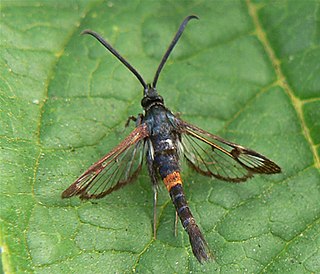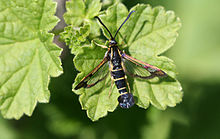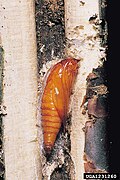
The Sesiidae or clearwing moths are a diurnal moth family in the order Lepidoptera known for their Batesian mimicry in both appearance and behaviour of various Hymenoptera.

The currant pug is a moth of the family Geometridae. The species was first described by Henry Doubleday in 1856. It is found across the Nearctic and Palearctic regions .Its occurrence extends eastwards to the Near East, Urals, the Ussuri region and on to the island of Sakhalin. In the Pyrenees and the Alps it rises to altitudes of 1500 and 1800 metres respectively.

The scalloped hazel is a moth of the family Geometridae. The species was first described by Carl Alexander Clerck in 1759.

The Adonis blue is a butterfly in the family Lycaenidae. It inhabits the Palearctic realm.

Lampides boeticus, the pea blue, or long-tailed blue, is a small butterfly that belongs to the lycaenids or gossamer-winged family.

Scopula immutata, the lesser cream wave, is a moth of the family Geometridae. It was described by Carl Linnaeus in his 1758 10th edition of Systema Naturae. It is found throughout Europe.

Pennisetia hylaeiformis, the raspberry clearwing, is a moth of the family Sesiidae.

Synanthedon myopaeformis is a moth of the family Sesiidae and the order Lepidoptera. In Europe it is known as the red-belted clearwing and in North America as the apple clearwing moth. The larvae create galleries under the bark of fruit trees, especially old trees with damaged trunks. During this process, the larvae cause significant damage to host trees. Particular attention has been paid to the damage they cause to apple trees. Their status as a pest of apple orchards has led to many research projects aimed at controlling populations of the moth. This moth is native to Europe, the Near East and North Africa. Recently, the moth was introduced into North America, being first detected in Canada in 2005. There are several organisms that threaten the larvae, including parasitoids, nematodes, and bacteria.

Synanthedon vespiformis, the yellow-legged clearwing, is a moth of the family Sesiidae. It is found in the Palearctic realm.

Hemaris thetis, the Rocky Mountain clearwing or California clearwing, is a moth of the family Sphingidae. The species was first described by Jean Baptiste Boisduval in 1855. It is found from Colorado, New Mexico, Montana, Idaho, Wyoming and Utah west to California and north to British Columbia. The habitat consists of streamsides and meadows in mountainous areas.

Bembecia ichneumoniformis, the six-belted clearwing, is a moth of the family Sesiidae.

Pennisetia marginata, the raspberry crown borer or blackberry clearwing borer, is a moth of the family Sesiidae. The species was first described by Thaddeus William Harris in 1839. It is widespread in the United States, mainly in the east and along the Pacific Coast, ranging north into the southern parts of Canada. It is an introduced species in Hawaii.

Synanthedon bibionipennis, the strawberry crown moth, is a moth of the family Sesiidae. It is found in western North America from Montana south to Texas westward to the Pacific coast and from British Columbia to California. It is an introduced species in Hawaii.

Synanthedon scitula, the dogwood borer or pecan borer, is a moth that is a pest of many plants including the dogwood and pecan. It is notorious due to the severity of damage it can cause and its widespread geographical distribution.

Synanthedon formicaeformis, the red-tipped clearwing, is a moth of the family Sesiidae and can be found in all of Europe, the eastern Palearctic realm, and the Near East. The larvae sometimes form pear-shaped galls on willows. It was first described by Eugenius Johann Christoph Esper in 1783.
Synanthedon flaviventris, the sallow clearwing, is a moth of the family Sesiidae. The larvae form pear-shaped galls on sallows.

Synanthedon scoliaeformis, the Welsh clearwing, is a moth of the family Sesiidae. It is found from almost all of Europe, east through Russia to Japan.
Content in this edit is translated from the existing German Wikipedia article at de:Synanthedon tipuliformis; see its history for attribution.




















